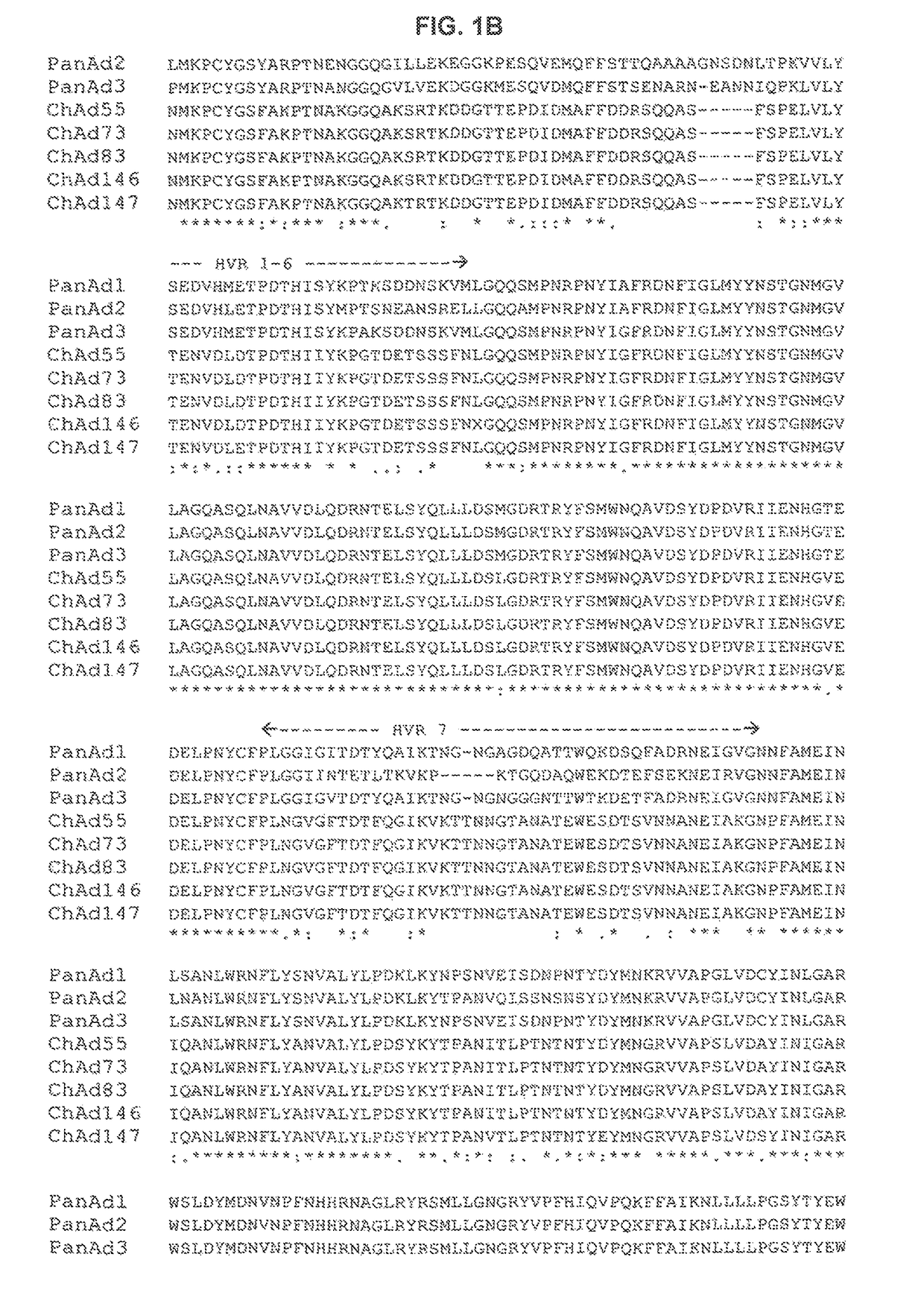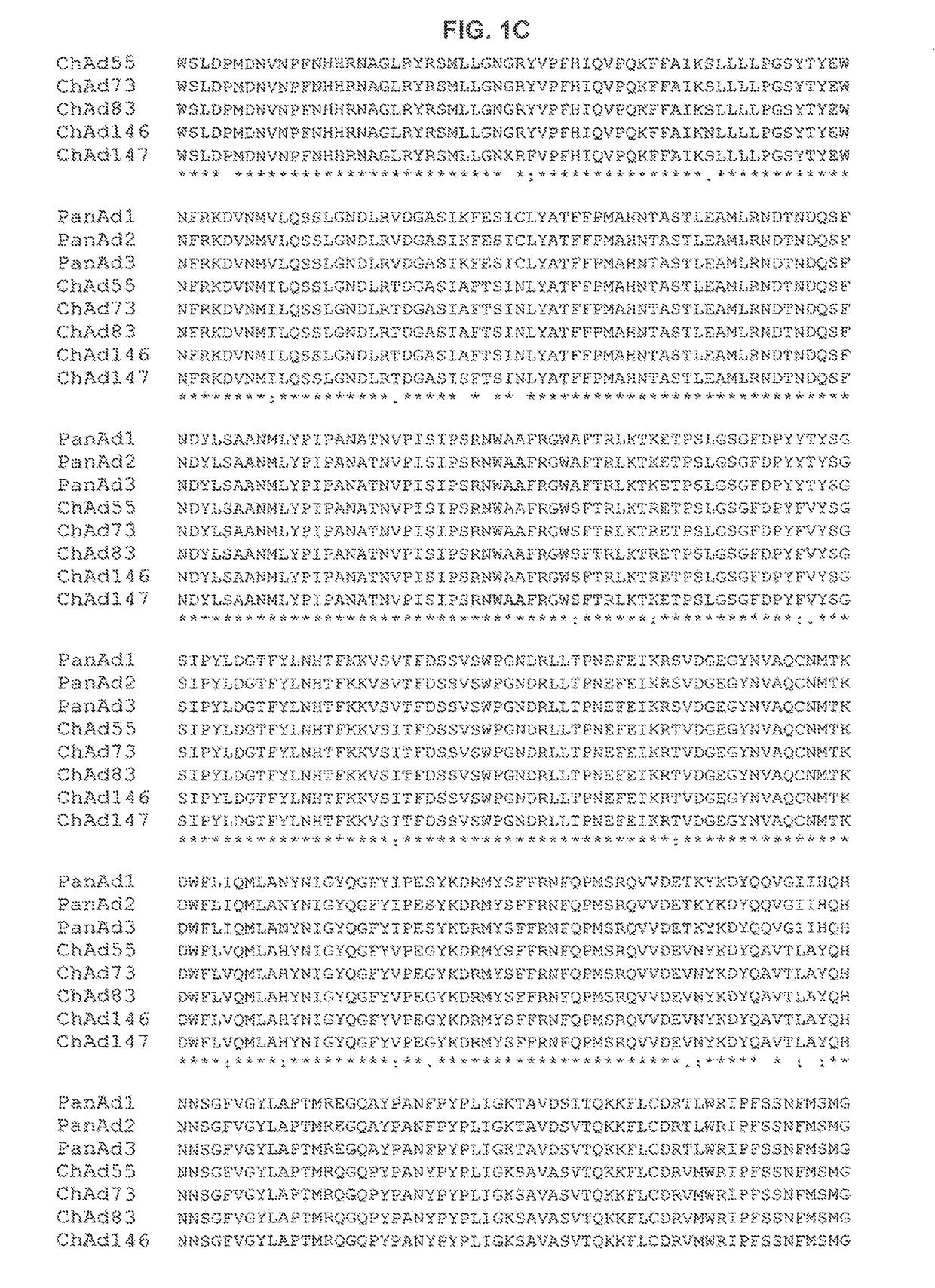Simian adenovirus nucleic acid- and amino acid-sequences, vectors containing same, and uses thereof
a technology of adenovirus and amino acid sequence, applied in the field of new viruses, can solve problems such as reducing the efficiency of gene transduction
- Summary
- Abstract
- Description
- Claims
- Application Information
AI Technical Summary
Benefits of technology
Problems solved by technology
Method used
Image
Examples
example 1
s Isolation and Characterization
[0248]ChAd55, ChAd73, ChAd83, ChAd146, ChAd147 are a group of chimpanzee adenoviruses obtained from healthy animals housed in different European and US facilities. ChAd55, ChAd73, ChAd83, ChAd146, ChAd147 have the property of no detectable reactivity with human sera. PanAd1, PanAd2 and PanAd3 are new adenovirus isolated from healthy bonobos (Pan Paniscus) housed in different European and US facilities. PanAd1, PanAd2 and PanAd3 have the property of no detectable reactivity with human sera.
[0249]The common chimpanzee and bonobo adenovirus stocks were cloned by infecting 293 cells seeded in 96-well plates, after the first passage of amplification. The virus cloning was performed by limiting dilution of the cell lysate obtained at the first passage of the virus amplification. 5 isolated clones were picked up and serially propagated. After 3-4 serial passages of amplification, a large-scale preparation of adenovirus was performed on cells planted on 5 two...
example 2
nstruction
[0253]The PanAd1, PanAd2 and PanAd3 and ChAd55, ChAd73, ChAd83, ChAd146, ChAd147 virus genomes were cloned in a plasmid vector following the strategy detailed below. All manipulations of the vector genome were performed in E. coli following standard techniques. Vector systems were developed by deleting E1 and E3 regions from ChAd and PanAd backbones. The E1 region was substituted with expression cassettes based on human CMV IE promoter and BGHpA signal containing HCV non structural region (HCV NS) and HIV gag (SEQ ID NO: 1) genes for the evaluation of the immunological potency in animal models. In addition, ChAd and PanAd vectors expressing the secreted alkaline phosphatase gene (SEAP) were constructed for the neutralization assay. The vectors were propagated in 293 cells and purified by CsCl gradients following standard protocols.
[0254]The construction of PanAd1, PanAd2 and PanAd3 AE1 vectors proceeded through the steps provided below.
I. Construction of PanAd Shuttle Vect...
example 3
ion Experiments
[0266]The efficiency of ChAd55, ChAd73, ChAd83, ChAd146, ChAd147, PanAd1, PanAd2 and PanAd3 vectors as potential recombinant vaccine was evaluated in mice with vectors expressing HIV gag transgene. The vector potency of ChAd55 gag was compared with human Ad5 gag in immunization experiments performed in parallel. Groups of 10 animals were injected in the quadriceps with a dose of the vector of 108 vp / mouse for Ad5gag or ChAd55gag (FIG. 5A). In a separate experiment a group of 5 animals were injected with a dose of the vector of 108 vp / mouse for Ad5gag or PanAd1gag, PanAd2gag and PanAd3gag (FIG. 5B). The potency of ChAd73 gag, ChAd83 gag, ChAd146 gag and Chad147gag was also determined by immunizing groups of 5 mice with a dose of vector of 108 vp / mouse in parallel with ChAd55 gag (FIG. 5C). The immune response elicited against HIV gag was measured by Interferon-γ Elispot assay on splenocytes. The results of immunization experiments with ChAd55, ChAd73, ChAd83, ChAd146, ...
PUM
| Property | Measurement | Unit |
|---|---|---|
| molecular mass | aaaaa | aaaaa |
| diameter | aaaaa | aaaaa |
| time | aaaaa | aaaaa |
Abstract
Description
Claims
Application Information
 Login to View More
Login to View More - R&D
- Intellectual Property
- Life Sciences
- Materials
- Tech Scout
- Unparalleled Data Quality
- Higher Quality Content
- 60% Fewer Hallucinations
Browse by: Latest US Patents, China's latest patents, Technical Efficacy Thesaurus, Application Domain, Technology Topic, Popular Technical Reports.
© 2025 PatSnap. All rights reserved.Legal|Privacy policy|Modern Slavery Act Transparency Statement|Sitemap|About US| Contact US: help@patsnap.com



